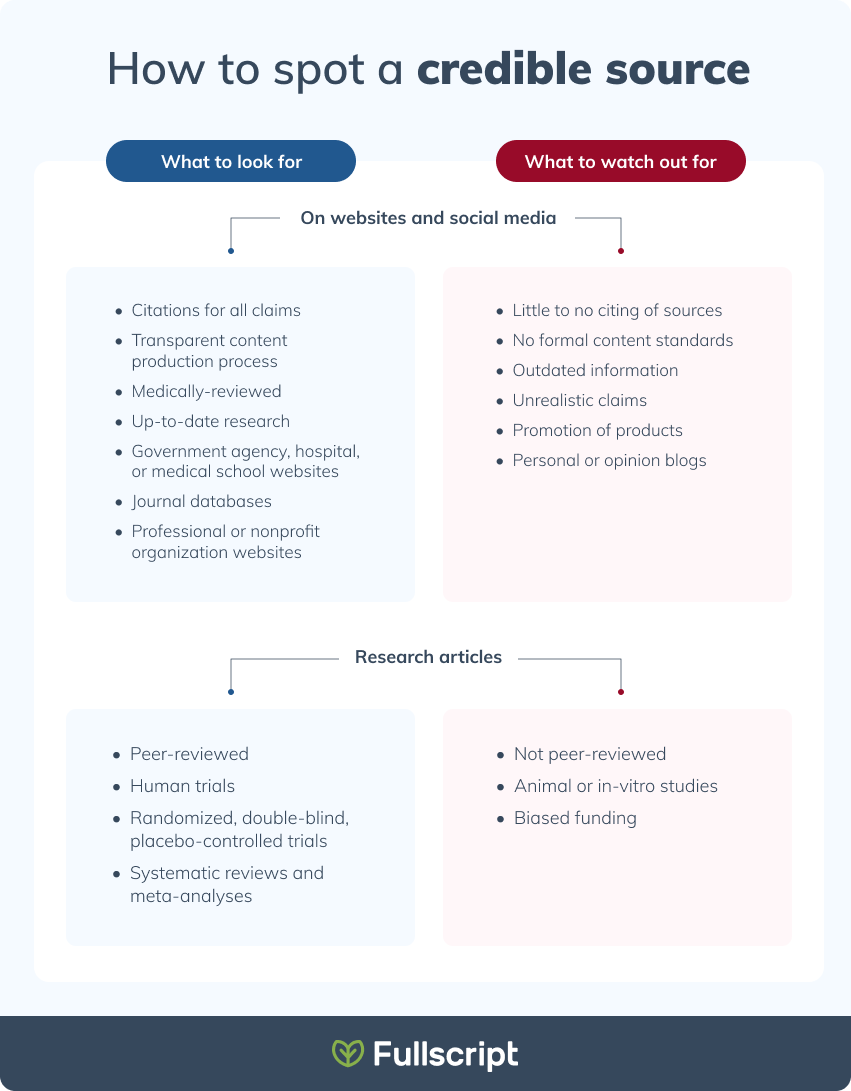We’ve all heard it before–“you can’t trust everything you read online.” Wading through hundreds of social media posts and website articles to find accurate health-related information can be challenging. The amplification of false health information can have real world consequences that can leave individuals feeling confused or untrusting of credible sources for health information. Furthermore, misinformation may even lead individuals to make dangerous, misinformed decisions about their health. (8)
With so much information out there, how can you determine what’s credible and what’s not? Keep reading to improve your health literacy by learning how to spot trustworthy sources for health-related information and learning the basics of interpreting scientific literature.
Did you know? False information spreads much faster than factual information. (8)

How to find reliable online health information
Credible health information is available on various health websites, social media platforms, podcasts, and more, but it takes some careful attention to decipher a trustworthy source over a lower quality one. Outlined below are some questions to consider when seeking out health-related information online.
Boost health literacy with 150+ evidence-based handouts for your patients
1. Whose website is it?
Be sure to source information from reputable organizations. Some of the best websites to gather evidence-based health information include:
- Government health agencies (e.g., National Institutes of Health (NIH), Centers for Disease Control and Prevention (CDC), Health Canada)
- Medical schools and hospitals (e.g., Harvard Medical School, Mayo Clinic)
- Online journals and research databases (e.g., PubMed)
- Professional or nonprofit organizations (e.g., Environmental Working Group (EWG), American Heart Association) (5)
2. What is the purpose of the website’s content?
Look for websites that provide information without explicitly trying to sell products or services or to promote personal opinions. (5) Many brands will have educational blogs on their websites; however, that isn’t necessarily a bad thing. It’s important to review any health-related content on a brand’s site to determine whether they are offering evidence-based information or simply trying to sell their product by making claims with no evidence to back it up.
3. Does the website have any content standards?
Check out the website’s “about” page or other pages for information about their content production process. Most reputable websites have a thorough content production process that may include an editorial board of health experts who review the content, information about the qualifications of their writers, and criteria for citing their work using only trustworthy sources such as peer-reviewed articles and government websites. (5)
Learn more about Fullscript’s content philosophy.
Did you know? Peer-reviewed research articles undergo evaluation by journal editors and various experts to verify the quality of the article and research. (7)
4. When was the information written?
Science is always evolving, so it’s essential to refer to sources providing the most up-to-date, evidence-based research. Look for published or last updated dates on websites, which can typically be found at the top or bottom of the webpage. (5) When looking for information on older topics, look for studies or articles published in the last ten years. For emerging topics, look for literature published in the past year or two. (2)
5. Does the website make health claims that sound too good to be true?
Be wary of websites and other media outlets that make unrealistic promises (e.g., lose 15 lbs in a week, or miracle disease control pill). More often than not, these sources are largely untrustworthy and may make outlandish statements to sell you a product that doesn’t work or isn’t safe. (5)
Tip: Mis- and disinformation spread fast on social media sites like Instagram, Facebook, and Twitter. Before accepting something as fact, even if you trust the person who posted it, check if the poster cited where they got their information. If the original source is less than trustworthy, or if the poster cannot provide their source, be skeptical of the information.

Interpreting scientific research
Whether you’re seeking information from PubMed or you’re interested in understanding research papers that have been cited by a media outlet, knowing how to interpret scientific research can give you the confidence to determine whether a source is trustworthy or not. Just because a study has been published on PubMed or in a credible medical journal does not mean it is the ultimate source of truth. So, how can you interpret a research article to determine whether it’s a reliable source? First, let’s look at the basic structure of a research article.
6 key sections of a research article
You don’t necessarily need to read a research paper in its entirety to understand the results and its significance. Most research papers include six sections summarizing the key takeaways from the study or review:
- Abstract: a short overview of what was researched and what the results were
- Introduction: an overview of the purpose of the study, what we already know about the topic being studied, any hypotheses (presumptions) being tested, and other important background information
- Method: an explanation of how researchers collected and analyzed data
- Results: a summary of the results without bias
- Discussion: an explanation of the results and how they relate to previous research findings from the perspective of the author(s)
- Conclusion: a summary of the main findings and the significance of those findings (1)

What to look out for in a research article
Consider the following questions when reading scientific literature.
1. Was the study conducted on human subjects or animals, or performed in vitro?
Many studies may be conducted in animals or in vitro (performed in a petri dish or test tube). While these types of studies can be enormously useful, they are generally preliminary studies and cannot be used to make conclusions about human health. (6)
2. How many people were involved in the study?
Look for studies involving larger sample sizes (number of individuals studied). A study involving 100 individuals is generally superior to studies involving only a few subjects as they provide more accurate results.
3. What was the duration of the study?
The duration of a study is an important factor to consider when reviewing scientific research. For example, if you’re looking for research investigating the effects of a particular diet over time, a study lasting several years may be more impactful than a study lasting only a few months.
4. What type of study was it?
Generally speaking, the most reliable and evidence-based sources of information come from systematic reviews and meta-analyses of human trials. Systematic reviews and meta-analyses review the findings of multiple studies to form a consensus. You can find systematic reviews and meta-analyses in PubMed’s database by following these steps:
- Go to the PubMed website.
- Search for a topic you’re interested in (e.g., type 2 diabetes, vitamin D).
- Use the filters along the left-hand side. Under “Article Types,” select “Meta-Analysis” and/or “Systematic Review.”
Other types of studies include:
- Randomized controlled trial: a study that randomly separates participants into two groups (an experimental group or a control group) to compare the effects of treatments
- Randomized, double-blind, placebo-controlled trial: a study that provides a treatment to a group and provides no treatment (placebo) to another group to test the effectiveness of the treatment, and in which neither the participants nor the researchers know who is receiving the treatment or the placebo
- Case-control: a study that involves interviews and evaluations of two groups of similar populations (e.g., same sex, age group) with and without a certain health condition
- Cohort: a study that observes two or more groups of people for several years to evaluate how each group is affected by a certain factor (e.g., a group of nonsmokers vs. smokers)
- Qualitative: evaluates information collected by speaking to people who have a certain health condition (3)

5. How was the research funded?
Watch out for research that may have conflicts of interest and be critical of internal research conducted by a company or industry as they may not be fully transparent about the results. For example, research funded or conducted by a dairy council regarding the benefits of consuming dairy products may not be the most reliable source of information. Instead, try to find research conducted by an impartial third party. (3)
Tip: You can usually determine the source of funding, or if there are any conflicts of interest, by looking for a funding statement or conflict of interest statement near the end of the research article.
The bottom line
Not all online health information is created equal, so be skeptical of what you read online. As a general rule, seek health information from your practitioner or reputable sources such as government agencies, peer-reviewed medical journals, medical schools, hospitals, and professional or nonprofit organizations.
If you’re a patient, have a conversation with your practitioner about your health concerns and ask them for their recommendations for finding credible sources for health information. Furthermore, always speak to your practitioner before adding or changing anything in your wellness plan.
- Carey, M. A., Steiner, K. L., & Petri, W. A. (2020). Ten simple rules for reading a scientific paper. PLOS Computational Biology, 16(7), e1008032.
- Chiang, I. A. (2015). Reviewing the research literature – research methods in psychology. 2nd Canadian Edition. https://opentextbc.ca/researchmethods/chapter/reviewing-the-research-literature/
- InformedHealth.org . (2016) What types of studies are there? Cologne, Germany: Institute for Quality and Efficiency in Health Care (IQWiG). https://www.ncbi.nlm.nih.gov/books/NBK390304/
- MedlinePlus. (2022). Evaluating health information. https://medlineplus.gov/evaluatinghealthinformation.html
- National Institute on Aging. (2018). Online health information: Is it reliable? https://www.nia.nih.gov/health/online-health-information-it-reliable#:%7E:text=The%20National%20Institutes%20of%20Health,visiting%20www.usa.gov
- National Institutes of Health. (n.d.). In vitro. https://clinicalinfo.hiv.gov/en/glossary/vitro
- National Library of Medicine. (n.d.). Peer-reviewed literature. https://www.nlm.nih.gov/nichsr/stats_tutorial/section3/mod6_peer.html
- Sylvia Chou, W. Y., Gaysynsky, A., & Cappella, J. N. (2020). Where we go from here: Health misinformation on social media. American Journal of Public Health, 110(S3), S273–S275.





